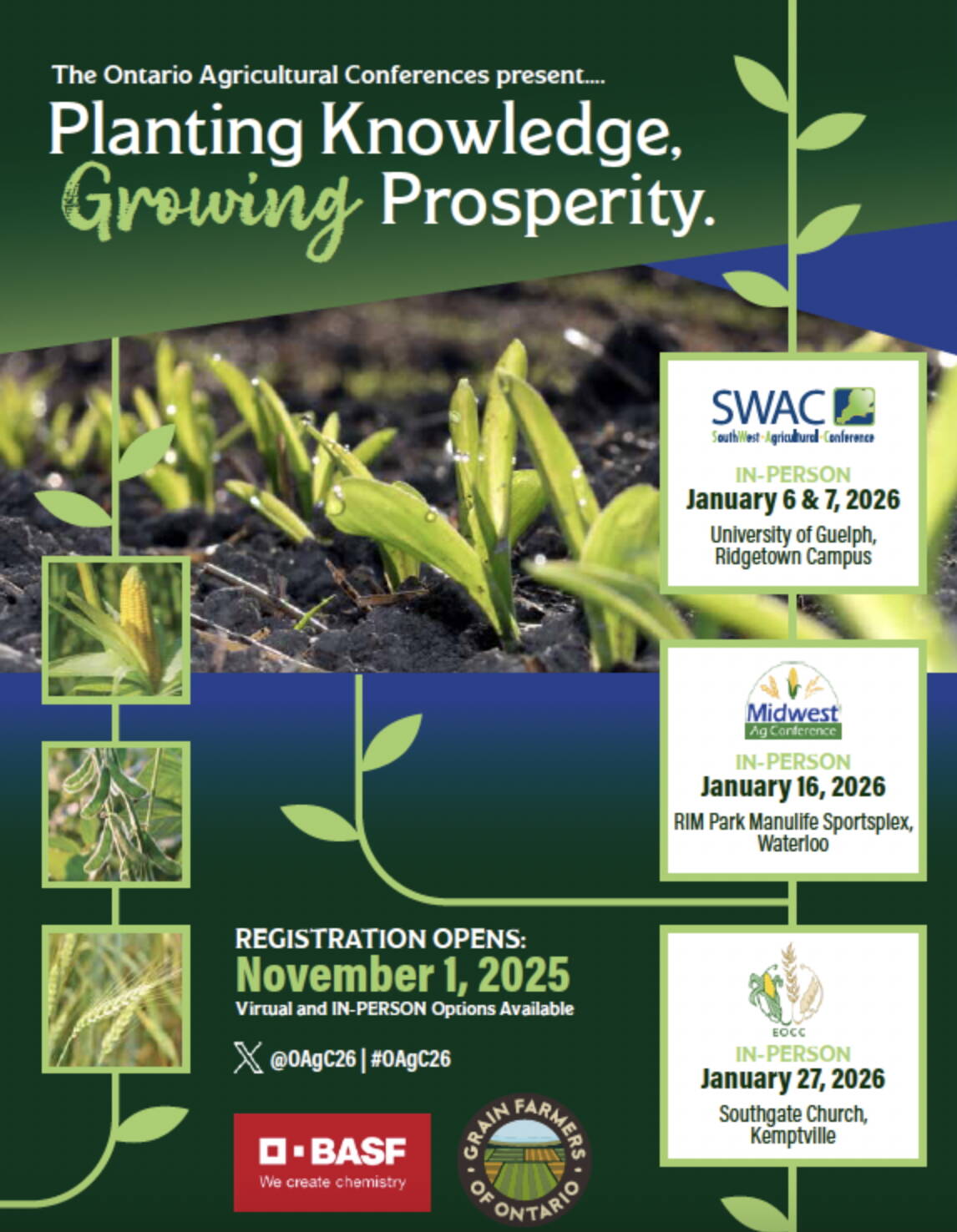Ontario corn and soybean planting progress is running seven to 14 days behind normal. A later planting period generally results in lower yields. Winter wheat is rated 70 per cent good to excellent.
Quick look
Soybeans:U.S. planting progress is lagging the five-year average, resulting in lower yield forecasts. Brazil continues to dominate the world market for soybeans while Argentina saturates soyoil and soymeal demand.
Corn Traders are factoring in lower production for the U.S. and Brazil. Leafhoppers in Argentina have trimmed crop prospects.
Wheat: The Russian wheat crop has experienced adverse weather. The forecast for June and July calls for limited precipitation in the main Russian winter wheat region. The world’s largest wheat exporter is in trouble after two years of bumper crops.
Soybeans
Read Also

Registration open for Ontario Agricultural Conference
The Ontario Agricultural Conference 2026 offers in-person and online access to expert insights, hands-on learning, and networking opportunities.
Ontario on-farm soybean stocks as of March 31 came in at 515,000 tonnes, which was lower than our forecast of 650,000 tonnes. We’re now forecasting the domestic crush from April 1 through July 31 to average 140,000 tonnes per month for a total domestic demand of 560,000 tonnes.
Soybean exports are estimated at 250,000 tonnes for the same four-month period. Total demand is estimated at 810,000 tonnes. The function of the Ontario soybean market is to ration demand. The market needs to trade high enough to attract imports from the U.S. while encouraging farmers to sell remaining stocks.
Basis levels will strengthen during June and July, which should result in higher prices. Ontario on-farm stocks will drop to historical lows at the end of the 2023-24 crop year. We continue to use a five-year average yield of 49.2 bu./acre to project 2024 production of 4.031 million tonnes. This is unchanged from last year but up 85,000 tonnes from the five-year average.
As of May 13, U.S. soybeans were offered at US$470/tonne f.o.b. the Gulf, up $20/tonne from two weeks earlier. Brazilian soybeans were quoted at $458/tonne f.o.b. Paranagua, up $23/tonne from the previous issue.
Strength in the world market is driving Ontario soybean prices higher. The Ontario domestic market needs to trade at a premium to world values to curb export movement.
The soybean futures market is incorporating a risk premium due to production uncertainty. On the May World Agriculture Supply and Demand Estimates (WASDE) report, the USDA used a trend yield of 52 bu./acre to project soybean production of 121.1 million tonnes, up from the 2023 output of 113 million tonnes.
Traders are factoring in lower yields due to later planting. At this stage, we’re factoring a yield 49 bu./acre, resulting in a production figure of 114 million tonnes. The U.S. fundamental structure for the 2024-25 crop year will be significantly tighter than the USDA forecast.
The final 10 per cent of the Brazilian harvest is dragging. on due to extreme precipitation and flooding. Trade estimates have Brazilian soybean production in the range of 153-155 million tonnes, down from last year’s crop of 162 million tonnes. Traders are comfortable with the USDA’s Argentine forecast of 50 million tonnes, which is double last year’s output. The Argentine soybean harvest is nearly 35 per cent complete. Argentine offers are becoming more aggressive for soymeal and soyoil. The country only exports about five million tonnes of soybeans.
What to do: We’ve advised farmers to be 80 per cent sold on 2023 production and 20 per cent sold on new crop. We’re planning to make our final sale in June or early July. We’re expecting a $1/bu. rally in the soybean market in early summer and plan to sell into this strength. We believe the U.S. has a production problem due to excessive rain.
Corn
Ontario corn stocks as of March 31 were 5.556 million tonnes. This included 2.694 million tonnes on farms and 2.862 million tonnes in commercial positions. The total stocks number was down 300,000 tonnes from our estimate and nearly one million tonnes below last year. Corn stocks are tighter than expected. Demand is unchanged.
Total domestic demand from April 1 through Aug. 31 is expected to be 3.9 million tonnes, while exports are projected to reach 900,000 tonnes. Total demand from April 1 through Aug. 31 is estimated at 4.8 million tonnes. Ontario on-farm corn stocks as of Aug. 31 are projected to be 320,000 tonnes, a historical low.
Commercial stocks as of Aug. 31 are estimated at 436,000 tonnes. The Ontario domestic corn market needs to trade at a premium to export values to curb export movement. Ontario 2024 corn production is estimated at 9.5 million tonnes, down from 9.6 million tonnes last year.
As of May 13, U.S. corn was offered at $205/tonne f.o.b. the Gulf, up $10/tonne from 14 days earlier. Brazilian corn was quoted at $215/tonne, up $7/tonne from two weeks prior. Argentine corn was quoted at $218/tonne f.o.b. tidewater. French corn was quoted at $230/tonne f.o.b. La Pallice. Ontario corn was valued at US$200/tonne f.o.b. St. Lawrence. Over the next six weeks, we’ll see Ontario f.o.b. values move to a $10/tonne premium over U.S. Gulf prices.
The May USDA WASDE report was considered bullish for the corn market. The 2023-24 ending stocks were decreased by 2.5 million tonnes due to stronger ethanol use and higher exports. For the 2024-25 campaign, the USDA used a trend yield of 181 bu./acre, resulting in production of 377 million tonnes, down from the 2023 output of 390 million tonnes.
The U.S. corn will be planted 10 to 14 days later than usual, which generally results in lower yields. We believe the trade is expecting a production number closer to 362 million tonnes.
In Argentina, leafhoppers caused lower crop prospects. The USDA lowered Argentine corn production from 55 to 53 million tonnes. Traders and private analysts believe the crop could be as low as 46 million tonnes.
For Brazil, corn output was lowered from 124 to 122 million tonnes. Traders and private analysts are estimating Brazilian corn production in the range of 112-116 million tonnes. The USDA tends to lower its forecasts once the crop is harvested, but traders have a bullish view on the world corn market due to lower production prospects.
What to do: This week, we are advising farmers to sell 10 per cent of their 2023 production, bringing total sales to 80 per cent. We’re expecting a weather market to develop in the summer, at which time we will sell the final portion. Given current production forecasts, we’ll be patient to sell new crop.
Wheat
Ontario on-farm wheat stocks as of March 31 were only 75,000 tonnes, down from the March 31, 2023 supplies of 260,000 tonnes. This is lower than expected by nearly 100,000 tonnes.
Ontario elevator bids were at 52-week highs on May 13 due to lack of producer selling. It appears that exports to Quebec and offshore were larger than anticipated.
Ontario on-farm wheat stocks will drop to bin-bottom levels at the end of the 2023-24 crop year. Ontario farmers are expected to harvest two million tonnes of winter wheat this summer, down from 2.7 million tonnes last year.
Southern Russia and Eastern Ukraine received less than 50 per cent of normal precipitation during March and April. Rains were forecasted for May. Longer-term forecasts call for below normal precipitation during June and July.
The USDA estimated Russian wheat output at 88 million tonnes, down from 91.5 million tonnes last year. SovEcon has the crop around 84 million tonnes but private trade estimates are in the range of 75-80 million tonnes. The world’s largest wheat exporter has a problem.
U.S. hard red winter wheat was estimated at 19.2 million tonnes, up from 15.9 last year. U.S. soft red winter wheat production was estimated at 9.3 million tonnes, down from the 2023 crop of 12.2. The U.S. will once again be a major destination for Ontario soft red winter in the 2024-25 crop year.
French soft wheat output is estimated at 31.4 million tonnes, down from 34.7 last year. German soft wheat is projected to finish near 18.8 million tonnes, down from the 2023 crop of 21.2. The main European harvest occurs in July and excessive rains have plagued main producers. Quality and final yields are uncertain.
Western Canada has received over 200 per cent of normal precipitation, resulting in planting delays. We’re expecting spring wheat production to finish near 25 million tonnes, up 2.4 million from last year. U.S. hard red spring is estimated at 12 million tonnes, down from 12.7 million tonnes last year. Western Canada will need optimal weather this fall.
Lower Russian production has been the main driver of the wheat rally, but a 75-80 million tonne crop is still considered burdensome for the market. U.S. farmers sell 50 per cent of their wheat in the summer months and this will cap the wheat rally.
What to do: This week, we’re advising Ontario farmers to finish old crop sales and sell the first 20 per cent increment of their 2024 expected production.















